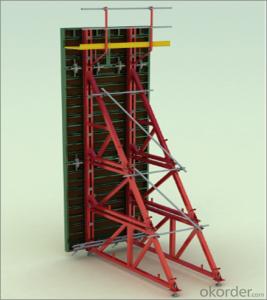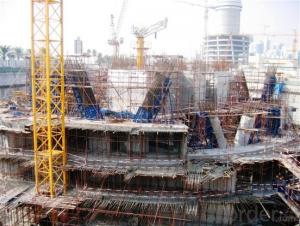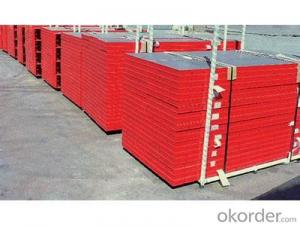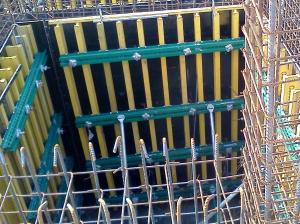Steel Frame Formwork of Flexible Assemble and Application
- Loading Port:
- Shanghai
- Payment Terms:
- TT OR LC
- Min Order Qty:
- 1 m²
- Supply Capability:
- 100000000 m²/month
OKorder Service Pledge
OKorder Financial Service
You Might Also Like
1. Structure of Steel Frame Formwork GK120
There is a prizing part designed in the corner, which can help to position and remove formwork easily.
The plywood is screwed on from the back when connecting frame and plywood, so the surface of the finished concrete is perfect.
The formwork series are a complete system with a full set of accessories, and can be set up flexibly according to project demand.
2. Main Features of Steel Frame Formwork GK120
Light weight
High strength
High standardized system
Easy connection with adjustable steel clamp
Convenient and fast corner formwork
Flexible to assemble and application
3. Steel Frame Formwork GK120 Images
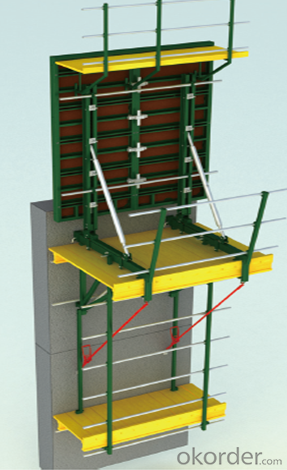
4. Steel Frame Formwork GK120 Specification
-The steel frame formwork is plywood covered with hollow steel. The plywood is 18 mm thick.
-The frame is highly strengthened, and the wall formwork can bear lateral pressure 60 KN/m2 while the column formwork can bear 80 KN/m2.
-As a standardized system, it is flexible to assemble , wood batten can be filled to satisfy the need f of non-standard size.
-The adjustable steel clamp is convenient to use, and can hold tightly.
-There is a prizing part designed in the corner, which can help to position and remove formwork easily.
-The plywood is screwed on from the back when connecting frame and plywood, so the surface of the finished concrete is perfect.
-The formwork series are a complete system with a full set of accessories, and can be set up flexibly according to project demand.
5. FAQ of Steel Frame Formwork GK120
1) What can we do for you?
.We can ensure the quality of the vinyl banner and avoid extra expenses for customers.
.We can provide you the professional design team.
.We can provide fashionable and newest styles for you.
.We can design the artwork for you.
. Please feel free to customize.
2) What promises can be done by us?
. If interested in Steel Frame Formwork GK120, please feel free to write us for any QUOTE.
. If printing required, please advise asap because the whole set need much more time to complete.
. Please DO check goods when courier knocks your door and contact us asap if any issue.
3) What about of our after-sale service?
. Response will be carried out in 24hours after receiving any complain or request.
. Steel Frame Formwork GK120 cost can be refund after order is confirmed.
. If the products are not based on the requirements, there will be the relevant compensations made for you.
4) What about the package and shipping time?
.Packing: As Customer's Requirements
.Shipping: We have various shipping ways for our customers, such as express which including TNT, DHL, FEDEX, UPS, EMS, etc. ; by air/ sea, and we are VIP of these express.
.Shipping time:
Normally small orders, it just 10-15 business days to arrive your hand; When comes to the customs declaration, it may need 7 days.
Other mass qty of Steel Frame Formwork GK120, we send them out by sea or by air to sea port or air port to save some shipping freight for our customers. By ocean, it may need 45~60days, by air, it may need 25~40days.
- Q:What are the different finishes available for steel frame formwork?
- There are several different finishes available for steel frame formwork, depending on the specific requirements of the construction project. One common finish is a galvanized coating, which involves applying a layer of zinc to the steel surface. This coating provides excellent corrosion resistance, making it suitable for projects in harsh environments or those exposed to moisture and chemicals. Galvanized finishes also have a smooth and uniform appearance, enhancing the aesthetic appeal of the formwork. Another option is a powder-coated finish, where a dry powder is electrostatically applied to the steel surface and then cured under heat. This coating offers durability, abrasion resistance, and a wide range of color options. Powder-coated finishes are ideal for projects that require a specific aesthetic or branding. For projects where the steel formwork needs to withstand extreme temperatures or high levels of wear and tear, a fire-resistant or heat-resistant finish may be applied. These finishes are designed to provide protection against fire, heat, and thermal shock, ensuring the longevity and safety of the formwork. Additionally, there are options for painted finishes that can be used to provide a decorative or protective coating on the steel frame formwork. Paint finishes can be customized to match the project's color scheme or to provide additional protection against corrosion. Ultimately, the choice of finish for steel frame formwork will depend on the specific needs of the project, including environmental conditions, desired aesthetics, and required performance characteristics. It is important to consult with a professional to determine the most suitable finish for a particular construction application.
- Q:What are the quality control measures for steel frame formwork production?
- To produce reliable and high-quality steel frame formwork, it is crucial to implement quality control measures. Some of the key measures include: 1. Thoroughly inspecting the raw materials used in steel frame formwork production. This involves checking the quality, dimensions, and specifications of the steel, as well as other components like connectors, nuts, or bolts. 2. Maintaining strict control over the production process to ensure quality. This includes monitoring and controlling factors like welding techniques, surface treatment, and dimensional accuracy throughout manufacturing. 3. Conducting regular quality assurance testing to ensure adherence to required standards. This can involve testing for strength, durability, load-carrying capacity, and dimensional accuracy. 4. Performing random inspections and testing of finished products to verify compliance with specified requirements. This includes checking for defects like cracks, deformations, or improper welding, and conducting load tests to verify structural integrity. 5. Maintaining proper documentation and traceability throughout the production process. This includes recording inspection and testing results, keeping records of raw materials used, and ensuring proper identification and labeling of finished products. 6. Continuously improving quality control measures. This involves regularly reviewing the production process, analyzing quality issues or customer feedback, and implementing corrective actions to enhance the quality of steel frame formwork production. By implementing these measures, manufacturers can ensure that steel frame formwork meets required standards, provides structural stability, and offers long-lasting performance for construction projects.
- Q:In the process of construction of reinforced concrete frame structure, the main contents of the quality inspection and monitoring of formwork engineering
- Template construction inspection items: 1, the template and the layout and construction of the scaffold is in line with the special construction organization design (program) and safety measures;
- Q:What are the different types of form ties used with steel frame formwork?
- Steel frame formwork commonly utilizes different types of form ties to ensure stability and strength. The following are examples of various form ties used: 1. Welded Form Ties: Form ties created by welding a metal plate onto one end of a steel rod. These plates securely connect to the formwork panels. 2. Coil Ties: Ties with a coil-shaped end that can be inserted into formwork panels and twisted to establish a tight connection. 3. She-Bolt Ties: Ties consisting of a threaded rod with a plate at one end, inserted through the formwork panel and secured with a nut, offering a strong and adjustable connection. 4. Flat Tie: Made of flat metal strips, these ties are inserted into formwork panels, commonly used for smaller applications. 5. Loop Ties: Ties featuring a metal rod with a loop at one end, inserted into formwork panels and twisted to ensure a secure connection. 6. Snap Ties: Ties composed of a metal rod with a loop at one end and a flat plate at the other. These ties are inserted into formwork panels and fastened with a snap tie wedge, providing a quick and efficient connection. These represent just a few examples of form ties used with steel frame formwork. The choice of tie depends on factors like the formwork system's size, complexity, and specific project requirements. Selecting the appropriate form ties is crucial to guarantee the safety and stability of the formwork structure.
- Q:How does steel frame formwork contribute to the overall construction process?
- Steel frame formwork is a crucial component in the overall construction process, as it provides a stable and durable framework for concrete placement. It offers several key contributions that enhance the efficiency and quality of construction projects. Firstly, steel frame formwork provides a reliable support system that ensures accurate and precise concrete pouring. The robust and rigid structure of the steel frames allows for the creation of complex shapes and structures, enabling architects and engineers to achieve their desired designs. This flexibility in formwork design helps in constructing various elements such as walls, columns, beams, and slabs with ease. Additionally, steel frame formwork is highly durable and can withstand the immense pressure exerted by the freshly poured concrete. This durability allows for multiple uses, reducing the cost and waste associated with disposable formwork systems. The longevity of steel frame formwork also contributes to sustainable construction practices by minimizing the need for frequent replacements. Moreover, steel frame formwork offers increased construction speed due to its ease of assembly and disassembly. The standardized components and modular nature of the system enable quick and efficient installation, saving valuable time on construction sites. This time-saving aspect is particularly beneficial in projects with tight deadlines or where rapid construction is required. Furthermore, steel frame formwork ensures excellent concrete finish and quality. The smooth surfaces produced by the steel frames minimize the need for additional surface treatments, reducing both time and cost. The precision and accuracy of the formwork system also help in achieving consistent results, ensuring uniformity and structural integrity in the final product. Lastly, steel frame formwork contributes to a safer working environment. The sturdy and stable structure provides a secure platform for workers to perform their tasks, reducing the risk of accidents and injuries. Additionally, the use of steel frame formwork eliminates the need for traditional timber formwork, which can pose fire hazards on construction sites. In conclusion, steel frame formwork plays a vital role in the overall construction process by providing a stable support system, enhancing construction speed, ensuring concrete quality, and contributing to a safer working environment. Its durability, flexibility, and efficiency make it an indispensable component for modern construction projects.
- Q:How does steel frame formwork affect the overall durability of a concrete structure?
- Steel frame formwork can significantly enhance the overall durability of a concrete structure. The use of steel as a formwork material provides numerous advantages that contribute to the long-lasting nature of the concrete construction. Firstly, steel frame formwork offers exceptional strength and rigidity, allowing it to withstand high pressure and heavy loads during the pouring and curing process of the concrete. This strength eliminates the risk of deformation or collapse during the construction phase, ensuring the structural integrity of the concrete structure. Moreover, steel is highly resistant to corrosion, which is a crucial factor in enhancing the durability of the concrete structure. Unlike other formwork materials such as wood or plywood, steel does not rot, warp, or deteriorate over time due to moisture or exposure to the elements. This resistance to corrosion ensures the long-term stability and strength of the concrete structure, even in harsh environmental conditions. Additionally, steel frame formwork offers superior dimensional stability, ensuring that the concrete elements maintain their intended shape and dimensions over time. This prevents any potential cracks or deformations from occurring in the concrete structure, thereby enhancing its overall durability. Furthermore, steel formwork allows for precise and accurate construction, resulting in minimal variations and imperfections in the finished concrete structure. This precision ensures that the structure is built to the desired specifications, reducing the risk of future issues or structural failures. Lastly, steel frame formwork is reusable, making it a sustainable and cost-effective choice for concrete construction. The ability to reuse the formwork reduces material waste and construction costs, while still maintaining the durability and quality of the concrete structure. In conclusion, steel frame formwork plays a pivotal role in enhancing the overall durability of a concrete structure. Its strength, resistance to corrosion, dimensional stability, precision, and reusability all contribute to a long-lasting and robust construction that can withstand the test of time.
- Q:What are the considerations for selecting the appropriate formwork for different concrete strengths?
- When selecting the appropriate formwork for different concrete strengths, several considerations need to be taken into account. First and foremost, the formwork should be able to withstand the pressure exerted by the concrete during pouring and curing. This means that the formwork should have sufficient strength and rigidity to prevent any deformation or collapse. Another important consideration is the surface finish required for the concrete. If a smooth surface finish is desired, the formwork should be able to provide a tight and even surface without any warping or distortion. On the other hand, if a textured or patterned surface is required, the formwork should be able to accommodate the necessary design elements. The duration of the project also plays a role in selecting the appropriate formwork. If a project has a short construction timeline, modular or reusable formwork systems may be preferred as they can be quickly assembled and disassembled, saving time and cost. Conversely, for long-term projects, traditional formwork systems may be more suitable. Lastly, cost considerations should be taken into account. Different types of formwork have varying costs associated with them, and the selection should be based on the project budget and financial feasibility. Overall, the considerations for selecting the appropriate formwork for different concrete strengths include strength and rigidity, surface finish requirements, project duration, and cost implications.
- Q:How does steel frame formwork handle the placement of embedded items and fixtures?
- Steel frame formwork is a versatile construction system that allows for easy handling and placement of embedded items and fixtures. Its modular design and adjustable features enable precise positioning of these elements within the concrete structure. The steel frames provide stability and support, ensuring that the embedded items and fixtures are securely held in place during the pouring and setting of the concrete. Additionally, the steel frame formwork allows for easy access and adjustments, making it convenient to install or modify embedded items and fixtures as per project requirements.
- Q:What are the quality control measures for steel frame formwork reassembly?
- Quality control measures for steel frame formwork reassembly involve several important steps to ensure the integrity and safety of the structure. These measures are vital to guarantee the proper functioning and durability of the steel frame formwork system. Here are some key quality control measures: 1. Visual Inspection: A visual inspection should be conducted to check for any visible damages or defects in the steel frame components. This includes inspecting the welds, joints, and connections for cracks, rust, or any signs of wear and tear. 2. Dimensional Accuracy: The steel frame components should be checked for dimensional accuracy to ensure they meet the specified requirements. This involves verifying the measurements, angles, and alignments of the components to ensure they align correctly during reassembly. 3. Material Testing: Material testing is an essential quality control measure to ensure the steel used in the frame formwork meets the required standards. This may involve conducting tests such as tensile strength, hardness, and chemical composition analysis to verify the quality of the steel. 4. Connection Verification: The connections between the steel frame components need to be thoroughly checked to ensure they are secure and properly tightened. This involves inspecting bolts, nuts, and fasteners to ensure they are correctly installed and torqued to the recommended specifications. 5. Load Testing: Load testing should be performed to validate the structural integrity of the reassembled steel frame formwork. This involves subjecting the structure to simulated or actual loads to ensure it can withstand the expected forces without failure. 6. Documentation and Record-Keeping: Keeping detailed records of all quality control activities is crucial for traceability and future reference. This includes documenting inspection results, test reports, and any corrective actions taken during the reassembly process. 7. Compliance with Standards and Regulations: It is essential to ensure that the reassembly process follows all relevant industry standards, codes, and regulations. This includes adhering to safety guidelines, structural design requirements, and any applicable local or national regulations. By implementing these quality control measures, companies can ensure that steel frame formwork reassembly is carried out with precision, safety, and adherence to industry standards. These measures contribute to the overall quality and longevity of the structure, minimizing the risk of failures or accidents during construction projects.
- Q:What are the components of a steel frame formwork system?
- A steel frame formwork system typically consists of several components that work together to create a strong and durable structure for concrete casting. These components include: 1. Steel frames: The main element of the system, steel frames provide the structural support and shape for the formwork. They are usually made of sturdy steel beams or columns that are welded or bolted together to create a framework. 2. Plywood panels: These are used to cover the steel frames and create the surface onto which the concrete is poured. Plywood panels are typically made of high-quality, durable plywood that can withstand the pressure of the concrete and provide a smooth finish. 3. Tie rods and wing nuts: These components are used to secure the plywood panels to the steel frames. Tie rods are threaded steel rods that pass through holes in the frames and panels, while wing nuts are used to tighten the rods and hold everything in place. 4. Formwork accessories: Various accessories are used to enhance the functionality and efficiency of the steel frame formwork system. These may include adjustable formwork clamps, corner brackets, formwork spacers, and connectors, among others. These accessories help in aligning and connecting the different components, ensuring stability and accuracy during the concrete casting process. 5. Formwork supports: These are used to provide additional support to the formwork system and distribute the weight of the concrete evenly. Supports can be in the form of adjustable props or scaffolding, which are placed beneath the formwork to prevent sagging or collapsing. Overall, a steel frame formwork system is designed to provide a robust and reliable structure for concrete casting. The combination of steel frames, plywood panels, tie rods, formwork accessories, and supports helps create a sturdy and adjustable formwork that can be used repeatedly for multiple concrete casting projects.
1. Manufacturer Overview |
|
|---|---|
| Location | |
| Year Established | |
| Annual Output Value | |
| Main Markets | |
| Company Certifications | |
2. Manufacturer Certificates |
|
|---|---|
| a) Certification Name | |
| Range | |
| Reference | |
| Validity Period | |
3. Manufacturer Capability |
|
|---|---|
| a)Trade Capacity | |
| Nearest Port | |
| Export Percentage | |
| No.of Employees in Trade Department | |
| Language Spoken: | |
| b)Factory Information | |
| Factory Size: | |
| No. of Production Lines | |
| Contract Manufacturing | |
| Product Price Range | |
Send your message to us
Steel Frame Formwork of Flexible Assemble and Application
- Loading Port:
- Shanghai
- Payment Terms:
- TT OR LC
- Min Order Qty:
- 1 m²
- Supply Capability:
- 100000000 m²/month
OKorder Service Pledge
OKorder Financial Service
Similar products
New products
Hot products
Related keywords

